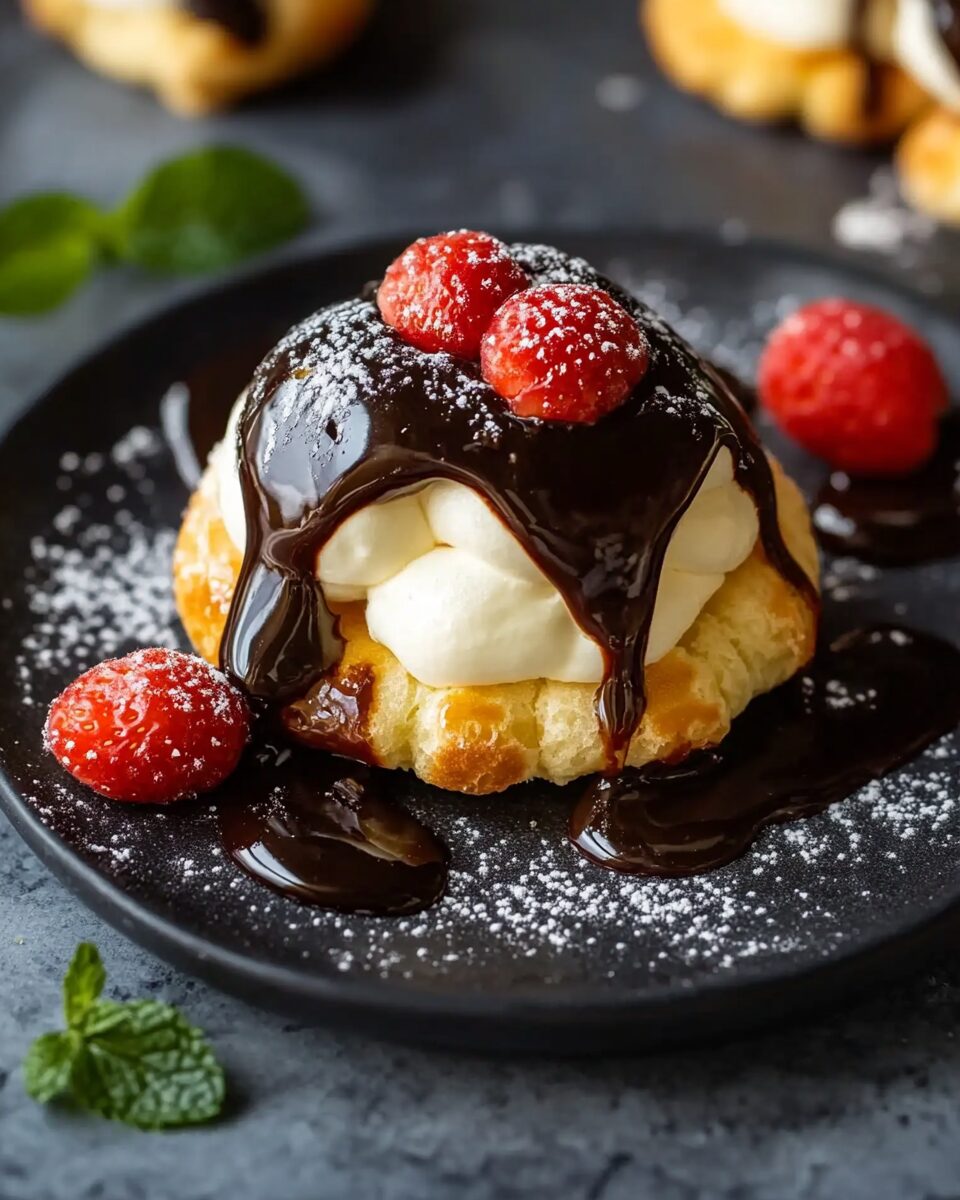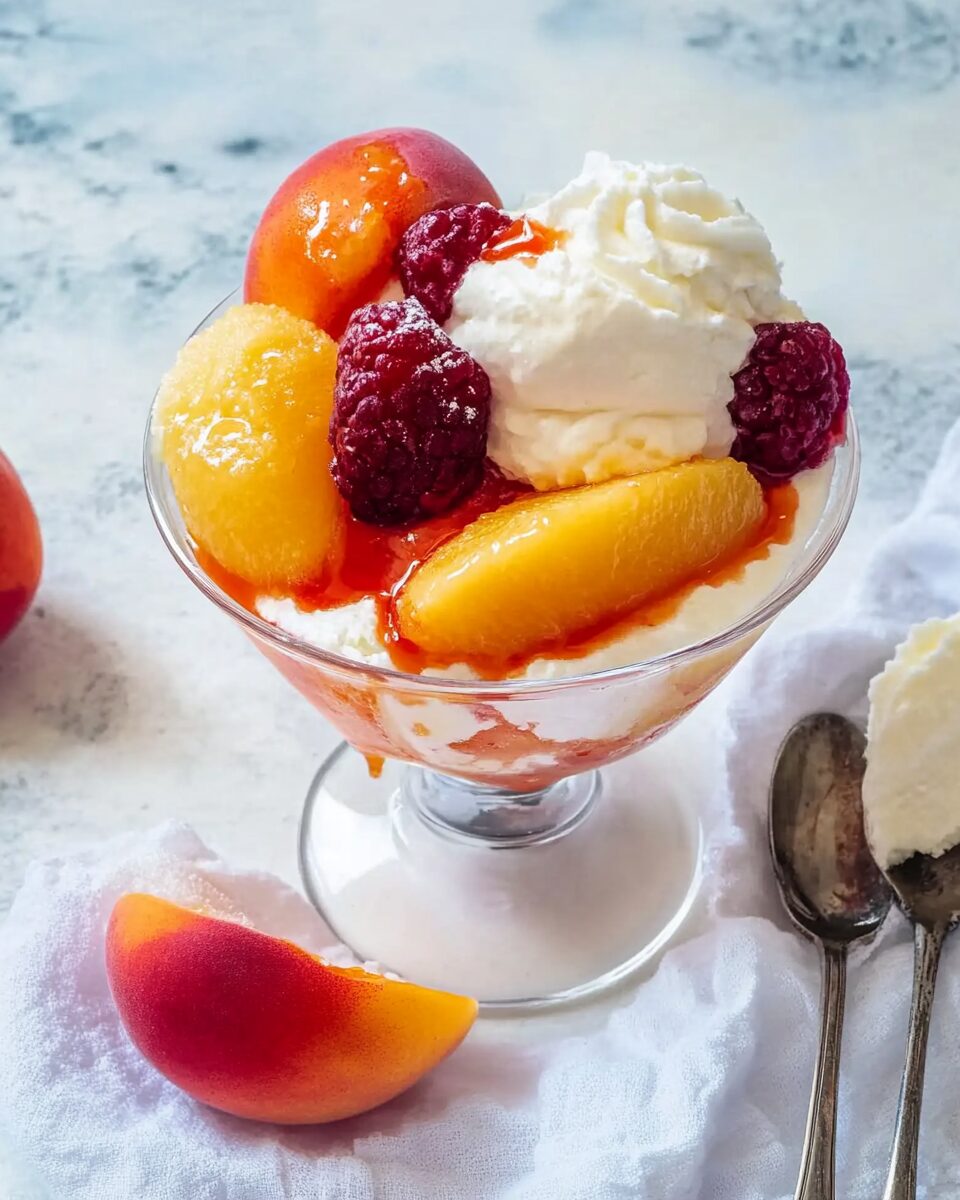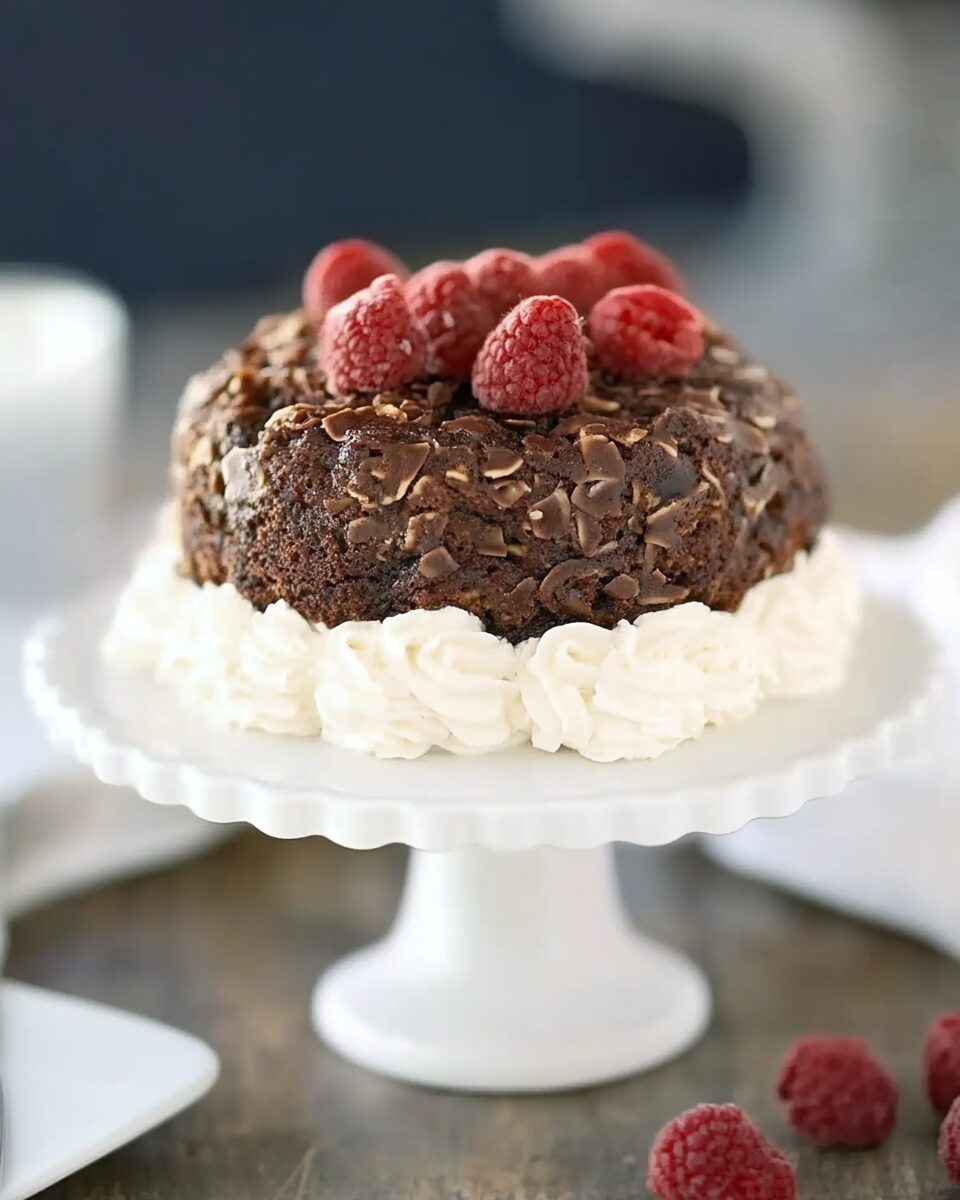Profiteroles, also known as cream puffs, are delightful French pastries made from choux pastry filled with sweet cream and topped with a rich chocolate glaze. These bite-sized treats offer a harmonious blend of textures and flavors, making them a favorite among dessert enthusiasts. Notably, this recipe yields approximately 30 profiteroles, each containing around 121 calories.
Full Recipe:
Ingredients
For the Choux Pastry:
- 75 ml whole milk
- 75 ml water
- 75 g unsalted butter
- 2 teaspoons granulated sugar
- ½ teaspoon salt
- ½ teaspoon vanilla extract
- 100 g all-purpose flour
- 3 large eggs (approximately 170g), at room temperature
For the Pastry Cream Filling:
- 3 large eggs
- ½ teaspoon salt
- 45 g cornstarch
- 150 g granulated sugar
- 550 ml whole milk
- 30 g unsalted butter
- 1 teaspoon vanilla extract
For the Chocolate Glaze:
- 100 g semi-sweet chocolate chips
- 100 ml heavy whipping cream
Directions
- Prepare the Choux Pastry:
- In a saucepan, combine milk, water, butter, sugar, salt, and vanilla extract. Heat over medium until the mixture boils.
- Remove from heat, add flour all at once, and stir until a smooth dough forms.
- Return to heat and cook, stirring continuously, for 2-3 minutes until a film forms on the bottom of the pan.
- Transfer the dough to a stand mixer, beat on low to cool slightly, then gradually add eggs, mixing well after each addition. The dough should be smooth and fall from the paddle in a V-shape.
- Preheat the oven to 190°C (375°F) and line a baking sheet with parchment paper.
- Transfer the dough to a piping bag fitted with a round nozzle. Pipe small rounds (about 2.5 cm in diameter) onto the prepared baking sheet, keeping them spaced evenly.
- Bake for 25-30 minutes until puffed and golden brown. Avoid opening the oven door during baking.
- Once baked, remove from the oven and let cool completely on a wire rack.
- Prepare the Pastry Cream Filling:
- In a bowl, whisk together eggs, salt, cornstarch, and sugar until smooth.
- In a saucepan, heat milk over medium until it begins to simmer.
- Slowly pour the hot milk into the egg mixture, whisking constantly to prevent curdling.
- Return the mixture to the saucepan and cook over medium heat, whisking constantly, until it thickens and boils.
- Remove from heat, stir in butter and vanilla extract until smooth.
- Transfer to a bowl, cover with plastic wrap (pressing it directly onto the surface to prevent a skin), and refrigerate until chilled, at least 1 hour.
- Assemble the Profiteroles:
- Using a small knife, make a hole in the bottom of each cooled puff.
- Fill a piping bag with the chilled pastry cream and pipe the filling into each puff until full.
- Prepare the Chocolate Glaze:
- In a heatproof bowl, place chocolate chips.
- In a saucepan, heat whipping cream over medium until it begins to simmer.
- Pour the hot cream over the chocolate chips, let sit for a few minutes, then stir until smooth.
- Allow the glaze to cool slightly to thicken to a pourable consistency.
- Glaze the Profiteroles:
- Dip the top of each filled profiterole into the chocolate glaze, allowing excess to drip off.
- Place the glazed profiteroles on a serving platter and refrigerate until the glaze sets, about 15 minutes.
Nutritional Facts (Per Profiterole)
- Calories: 121 kcal
- Fat: 7 g
- Saturated Fat: 4 g
- Carbohydrates: 14 g
- Sugars: 8 g
- Protein: 2 g
- Cholesterol: 35 mg
- Sodium: 50 mg
- Fiber: 1 g
The History of Profiteroles
Profiteroles have a long and storied history, dating back to the 16th century in France. They were initially created by the famous French chef Antonin Carême, who is often regarded as the father of haute cuisine. Carême is credited with perfecting choux pastry and creating the first profiteroles, which were originally served as small puffed pastries filled with savory ingredients such as cheese or meat.
Over time, the recipe for profiteroles evolved, and by the 19th century, they had become a popular dessert, filled with sweet creams and drizzled with chocolate. The name “profiterole” is thought to be derived from the French word “profit,” referring to a small benefit or reward. It’s said that the small size of the pastries and their sweet, indulgent filling made them a perfect treat for rewarding oneself or offering a little pleasure.
Today, profiteroles are a beloved dessert not only in France but also around the world. They have become synonymous with luxury and indulgence, often served at weddings, celebrations, and festive occasions.
The Secret Behind the Perfect Choux Pastry
The key to making the perfect profiteroles lies in the choux pastry itself. Choux pastry, or pâte à choux, is unique because it doesn’t require any leavening agents such as yeast or baking powder. Instead, it relies on steam to puff up the dough as it bakes, creating hollow centers perfect for filling with creamy fillings like pastry cream, whipped cream, or even ice cream.
The process of making choux pastry involves a careful balance of ingredients, technique, and timing. The dough is first cooked on the stovetop to ensure that the water and butter are fully incorporated, and the flour forms a smooth dough. After cooking, the dough is cooled slightly before adding eggs one at a time. The eggs give the dough its structure and help it rise during baking. It’s important to mix the dough well at this stage to ensure a smooth and elastic texture that will puff up beautifully in the oven.
One of the most critical steps in making choux pastry is to bake the profiteroles at a high temperature, which allows the steam to expand and create the characteristic puff. Once baked, the shells should be golden brown, crisp on the outside, and hollow on the inside.
Pastry Cream: The Heart of Profiteroles
The filling of profiteroles is just as important as the choux pastry itself. Traditionally, profiteroles are filled with pastry cream, also known as crème pâtissière, which is a rich, custard-like filling made from milk, eggs, sugar, and cornstarch. This creamy filling adds a luxurious texture and flavor to the profiteroles, balancing the lightness of the choux pastry.
Making pastry cream requires careful attention to ensure that the custard doesn’t curdle. The process starts by heating milk and sugar together, then slowly adding this mixture to a blend of eggs, cornstarch, and vanilla. The custard is then cooked over medium heat until it thickens to the consistency of heavy cream. After cooking, the pastry cream is cooled and placed in a piping bag to fill the profiteroles. The result is a smooth, velvety cream that complements the crisp pastry perfectly.
While traditional profiteroles are filled with pastry cream, there are many variations to suit different tastes. Some people prefer whipped cream, chocolate mousse, or even fruit fillings for a lighter, fresher twist on the classic.
Chocolate Glaze: The Finishing Touch
The final step in creating the perfect profiteroles is the chocolate glaze. The glaze is typically made from semi-sweet chocolate and heavy cream, which are combined and heated to create a smooth, glossy coating. The chocolate glaze is poured over the top of each profiterole, creating a beautiful, shiny finish that contrasts perfectly with the light, airy pastry and the creamy filling inside.
The chocolate glaze not only enhances the flavor of the profiteroles but also adds a layer of richness that makes them truly indulgent. For those who enjoy a more complex flavor profile, the glaze can be infused with ingredients like coffee, orange zest, or liqueurs, such as Grand Marnier or Chambord, for a unique twist.
Variations on the Classic Profiterole
While the traditional profiterole is filled with pastry cream and topped with chocolate glaze, there are many ways to customize this classic dessert. Here are a few popular variations:
-
Ice Cream Profiteroles: Instead of pastry cream, you can fill the profiteroles with ice cream for a cool, refreshing treat. Chocolate, vanilla, or fruit-flavored ice creams work well, and the addition of the chocolate glaze adds an extra layer of decadence.
-
Savory Profiteroles: While sweet profiteroles are the most common, savory profiteroles are also a popular option. These can be filled with ingredients like cheese, whipped cream cheese, or even smoked salmon for a unique appetizer or party snack.
-
Caramel Profiteroles: For a different kind of sweetness, some recipes call for caramelized sugar or a rich caramel sauce in place of the chocolate glaze. This adds a deep, buttery flavor that pairs beautifully with the light pastry.
-
Fruit-Filled Profiteroles: A fresh fruit filling, such as berries or citrus, can be used to balance the richness of the choux pastry and cream. This variation offers a fresher, lighter version of the traditional dessert.
Serving Suggestions
Profiteroles are often served as an elegant centerpiece at gatherings and celebrations. Their individual size makes them easy to serve to guests, and they can be presented in a variety of ways. A classic option is to serve them on a large platter, drizzled with the chocolate glaze and garnished with a dusting of powdered sugar. For a more dramatic presentation, profiteroles can be stacked to create a towering “croquembouche,” a traditional French wedding dessert that is both beautiful and delicious.
If you’re serving profiteroles as a part of a dessert buffet, they pair well with other French pastries such as éclairs, tarts, or macarons. For a complete dessert experience, they can also be served alongside fresh berries or a rich fruit compote.
The Joy of Making Profiteroles at Home
Making profiteroles from scratch may seem like a daunting task, but with the right recipe and technique, it’s a rewarding and enjoyable process. The key is to take your time and pay attention to the details—whether it’s carefully mixing the choux pastry, ensuring the pastry cream is smooth and thick, or making sure the chocolate glaze is perfectly glossy. The result is a batch of profiteroles that are as impressive as they are delicious.
Additionally, making profiteroles at home allows you to customize the recipe to suit your preferences, whether you prefer a lighter filling or a richer chocolate glaze. There’s something special about creating these elegant pastries from scratch and sharing them with friends and family.
Conclusion
Profiteroles are a timeless dessert that has captured the hearts of pastry lovers for centuries. Their light, airy choux pastry, rich pastry cream filling, and decadent chocolate glaze create a perfect balance of textures and flavors. Whether you enjoy them as a classic dessert or prefer to experiment with different fillings and toppings, profiteroles are sure to impress and satisfy any sweet tooth.








